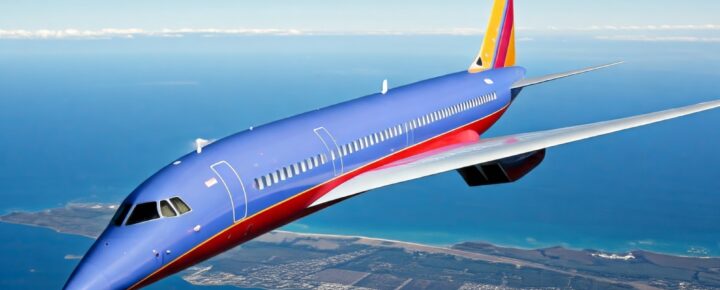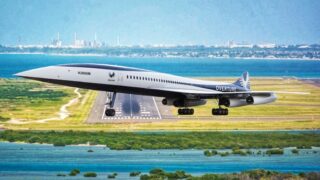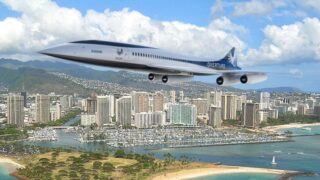Blake Scholl, CEO of Boom Supersonic, reportedly just made a bold pitch suggesting that Southwest Airlines could eventually operate supersonic flights between the U.S. mainland and Hawaii. While this idea might sound either ambitious or ludicrous, for a myriad of reasons, it nonetheless raises fascinating questions about the future of travel to the islands.
Could Southwest be the airline that brings supersonic flights to Hawaii, making quick getaways a reality? Given Southwest’s budget-friendly model and the complexities and cost of supersonic travel, we’re not convinced. But let’s explore this prospect further and what it could mean for the future of Hawaii travel.
Scholl suggested that travelers might soon catch a glimpse of Boom’s Overture aircraft on flights to Hawaii. Although there’s no formal partnership in place, the concept once again hints at a future where flying to Hawaii could take just a few hours, drastically reducing the current five to six-hour journey from West Coast cities. This potential leap in travel efficiency offers an exciting, albeit uncertain, vision for the future of luxury Hawaii travel.
Boom’s vision is taking flight: supersonic travel over the Pacific.
Boom has been steadily moving its vision forward with test flights of its XB-1 aircraft over the Pacific, paving the way for supersonic speed test flights before the end of this year. A significant milestone was recently achieved when the FAA granted Boom authorization to exceed Mach 1, a critical step toward demonstrating the aircraft’s capabilities. This development on the test aircraft isn’t any guarantee of a commercial jet, however.
Beat of Hawaii has been covering the development of Boom Supersonic.
That includes, first and foremost, the potential impact on Hawaii travel, given that the state could be included in the future of supersonic flight routes.
Major airlines are showing growing interest, including United Airlines, which has committed to purchasing 15 Boom Overture jets, with an option for an additional 35, marking a significant investment in the future of high-speed travel. American Airlines followed suit, placing a non-refundable deposit for up to 20 of these aircraft, with an option for an additional 40, while Japan Airlines has also shown interest, pre-ordering up to 20 jets. These commitments signal at least some degree of confidence in Boom Supersonic’s vision and suggest that such luxury travel to Hawaii might come to fruition.
Many of our readers have expressed excitement about this possibility, while others have dismissed the entire notion of supersonic Hawaii flights.
For instance, Douglas M shared, “Will definitely buy a ticket to get to Hawaii at supersonic speed. Beautiful aircraft.”
Similarly, Lisa T said, “OMG, 2 hours to Hawaii would be so awesome!” These comments reflect one aspect of comments amid the growing anticipation of faster travel options to paradise.
Southwest Airlines and the big cost question.
While Southwest Airlines, currently in the midst of an upheaval, is known for its no-frills service, many are wondering how the airline could conceivably incorporate the high price of supersonic travel into its current or any future business model. Boom’s CEO claims that supersonic travel can eventually be made affordable, but as Richard aptly noted in his comment, “Supersonic travel is for business, not for leisure travel… It’s more cost-effective to have airlines fly slower planes to leisure markets.”
Could Southwest find a way to keep costs reasonable for supersonic flights?
For now, the prospect of reaching Hawaii in half the time might justify a premium price, but it remains to be seen how that fits into any Southwest approach.
Addressing multiple challenges and concerns.
The sonic boom problem is a major concern for supersonic travel over land, which adds to Hawaii’s allure.
Keith H commented, “Until they fix the sonic boom problem, supersonic travel will never be useful to the masses.”
However, since flights to Hawaii take place over water, the impact might be lessened, making it a more feasible market for early supersonic routes. Boom’s use of sustainable aviation fuel (SAF) also aligns with the commitment to eco-friendly Hawaii tourism, though questions about fuel efficiency and environmental impact still linger.
The industry is closely watching how Boom will navigate engine development without the support of established engine manufacturers, as this technology is both complex and demanding innovation. Achieving the right balance of power, noise reduction, fuel efficiency, and environmental compliance remains one of the biggest hurdles for Boom, as we’ve highlighted in numerous previous articles and comments. This is particularly crucial for routes to Hawaii, where maintaining a sustainable approach is vital, and addressing these challenges will determine the feasibility of supersonic travel becoming a reality here.
The future of Hawaii supersonic travel: excitement vs. reality.
The idea of supersonic flights to Hawaii continues to generate buzz, but some (including us) remain skeptical about whether they can truly cater to leisure travelers.
As commenter CJ reflected on his prior Concorde experience, “Flying supersonic is the way of the future, but I would not be able to afford the price of a ticket.”
This tension between speed and affordability is one defining factor in whether supersonic travel can succeed in Hawaii. For now, Boom is moving ahead with its plans
What do you think?
How much more would you be willing to pay to reach Hawaii in just a few hours? Share your thoughts in the comments below!
This was previously reported by Simple Flying.
Photo created by Google photo generator.
Get Breaking Hawaii Travel News






There was a time when we took risks and pushed the boundries to advance technology and implemented their use…sadly, not so much anymore. Because we are so “tentative” and things like “environmnetal impact studies” take decades, this technology will never be put into production. Hope I am wrong but I doubt it.
I just can’t envision Boom aircraft, assuming they make it into production, being a regular visitor to Hawaii. The price point needed to make the aircraft financially viable will keep it away from most leisure destinations and focused solely on higher-yielding business routes.
It’s not just the cost of the aircraft SW would have to consider, it would also have build and maintain a maintenance base and logistics system, acquire and train personnel and aircrew experienced in supersonic flight, work out permissions for flight profiles, etc, and try to do it all depending on a tiny sliver of the flying customer base… Many Billions of dollars would be needed just to get it off the ground. Not sure SW has the assets and resources to do this even if their board would allow it… Would also require across the board price increases to pay for it all…
Best Regards
The thought of shorter flights is Awesome, but the costs do not make it realistic. When you consider you would be looking at 8 to 10k for a ticket.
IF supersonic flights could be carbon costs neutral compared to regular current modes, all in favor. Otherwise, let’s not destroy earth’s atmosphere faster than we are.
Based on current assumed ticket pricing, and the limited route structuring (no overland sonic “booms”), perhaps a viable starting point would be a mainland one-stop US/ HI/ Tokyo or Seoul route.
I don’t believe the Overture would have the long range as a B787 or A350, so perhaps savvy business travelers would sacrifice that one stop for a six or seven hour trip to the Far East.
IMO don’t think boom will happen. One sonic boom and Hawaii will think it is Pearl Harbor all over again.
You haven’t been there when the Hawaiian Air National Guard performs their standard vertical departures from HNL, have you? It might not be a sonic boom, but it sets off car alarms all over Sand Island every time.
Two important points – cost and safety.
Demographics that will find this affordable will be very small just like the impact it will have on the number of visitors.
I hope that this company is more skilled and more responsible than the company whose name we don’t need to mention here.
LOL, Well I like the idea, however we both know that this is not something SW will do. Just maybe United.
While flying supersonic between Hawaii and the mainland is alluring to the rich and famous, the “time is essential” business travelers, and to the “once in a lifetime” adventurers who can afford it, the actual customer base for this route may be restricted to only those three classes of Hawaii visitors. The vast majority of Hawaii travelers don’t fit into those categories. To them, an extra two-three hours of travel time to save hundreds (maybe thousands) of dollars is a no brainer.
I would be willing to pay a buck 380 more. Which means that flights are pricey enough for the average traveler, especially if you add extras like reasonable legroom or expensive first class seats. I am thinking that anyone wanting to pay more a boom flight will want a fully comfortable experience and that a seat will run at least 2x the cost of current first class, so $3000+ per leg. The average tourist could not afford that and we will only be catering to the very rich, not my idea of the future of Hawaii tourism.
I love visiting a lovely small mountain city in Mexico, which has remained desirable because the nearest airport is a 2.5 hour drive away and so “convenience” travelers do not come and crowd out local residents and those of us willing to endure the inconvenience of slow travel. Let’s all slow down and enjoy the flowers and birds.
I’ve said it before, I’ll say it again – wake me up when they’ve got an airliner flying. Or at least in taxi trials.